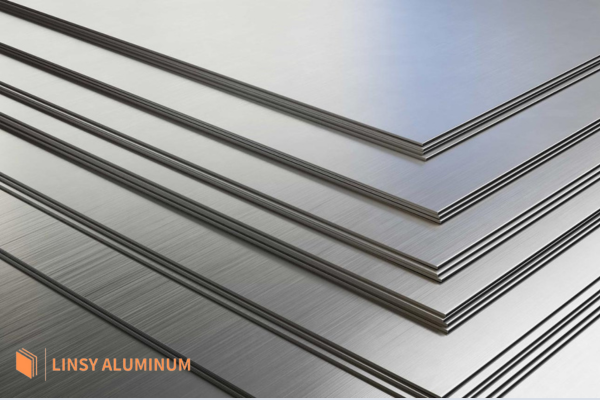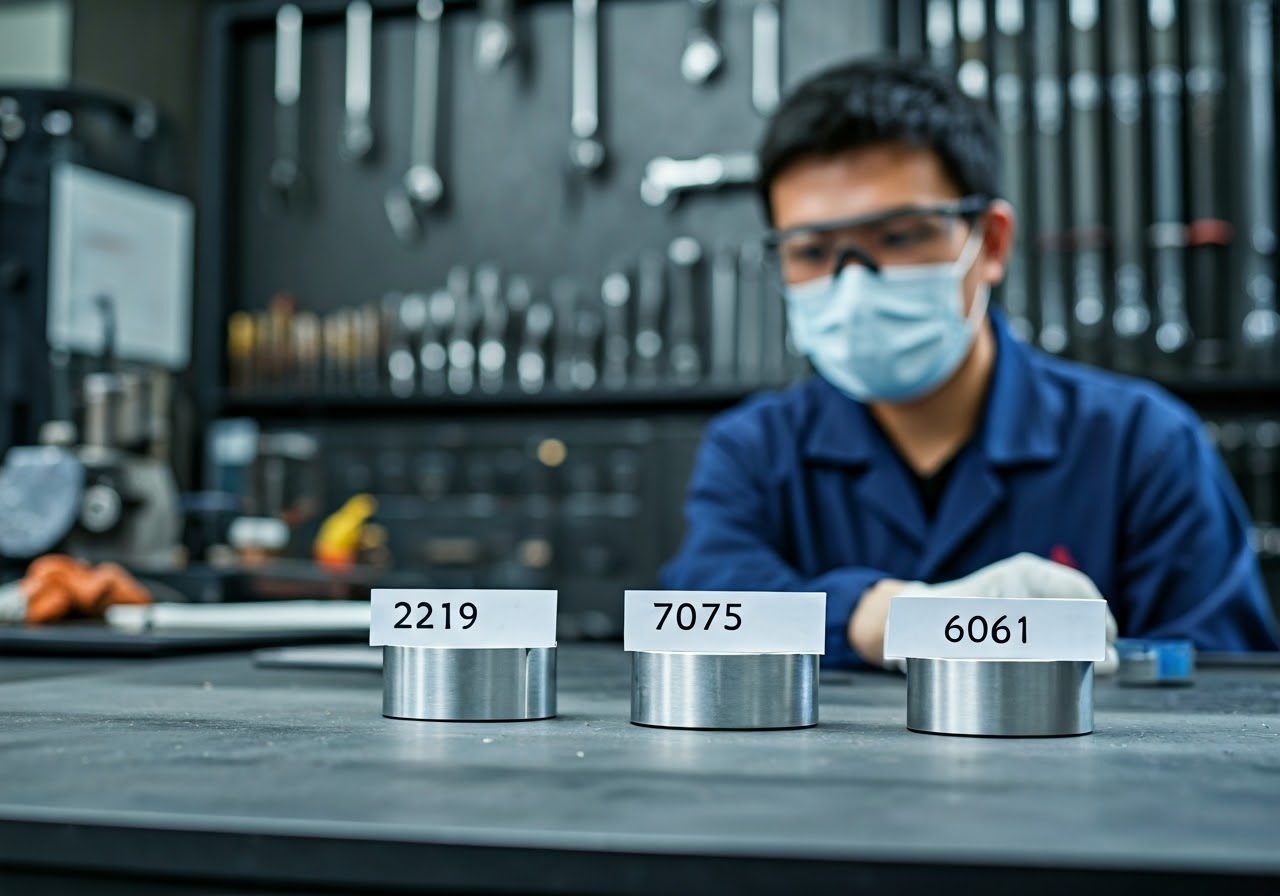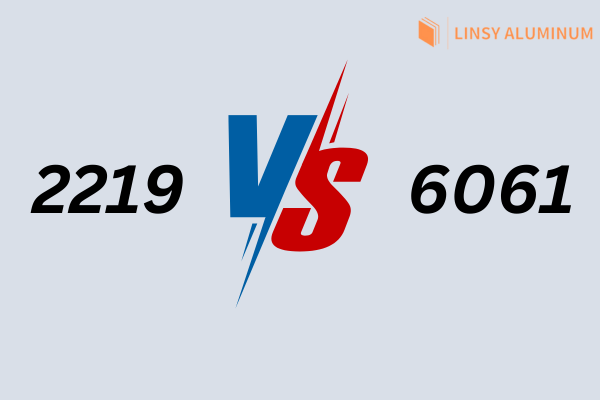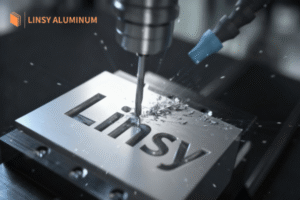Key Highlights
-
2219 aluminum alloy is renowned for its high strength, excellent weldability, and impressive performance across a broad temperature range.
-
This alloy is extensively used in demanding aerospace applications, such as fuel tanks and aircraft structural components.
-
Its notable characteristics are its exceptional fracture toughness and remarkable corrosion resistance.
-
The alloy’s composition primarily consists of aluminum, with copper as its major alloying element, which contributes to its robust mechanical properties.
-
Adding elements such as manganese, zinc, vanadium, and titanium further enhances its strength and weldability.
-
2219 aluminum alloy is offered in various product forms, such as bars, sheets, plates, and forgings, showcasing its versatility in manufacturing.
Introduction
2219 aluminum alloy is a premium choice for high-strength applications, particularly in aerospace. Its unique mechanical properties make it a top contender for use in challenging environments. This comprehensive guide will explore the properties, advantages, and applications of 2219 aluminum alloy, focusing on its significance in structural applications.
What Is 2219 Aluminum Alloy
2219 aluminum alloy belongs to the heat-treatable aluminum alloy family, celebrated for its exceptional strength and impressive corrosion resistance. This alloy is renowned for retaining its strength even at elevated temperatures, making it particularly well-suited for demanding applications.
Its superior strength stems from carefully adding copper as the primary alloying element, complemented by smaller additions of manganese, zinc, vanadium, and titanium. These alloying elements work synergistically to boost 2219 aluminum’s strength, weldability, and overall performance, solidifying its position as a leading material in demanding industries like aerospace.
Chemical Compositions of 2219 Aluminum
|
Element |
Content (%) |
|---|---|
|
Aluminum, Al |
Balance (91.5 to 93.8%) |
|
Copper, Cu |
5.8 to 6.8 |
|
Iron, Fe |
0.3 max. |
|
Magnesium, Mg |
0.02 max. |
|
Manganese, Mn |
0.2 to 0.4 |
|
Silicon, Si |
0.2 max. |
|
Titanium, Ti |
0.02 to 0.10 |
|
Vanadium, V |
0.05 to 0.15 |
|
Zinc, Zn |
0.1 max. |
|
Zirconium, Zr |
0.10 to 0.25 |
|
Residuals |
0.15 max. |
The remarkable properties of 2219 aluminum alloy can be attributed to its finely tuned chemical makeup. Aluminum (Al) forms the base of this alloy, comprising the most significant percentage. Copper (Cu) is the primary alloying element, present in significant quantities, and plays a crucial role in enhancing the alloy’s strength.
Furthermore, manganese (Mn) is added to improve the alloy’s strength and machinability, while additions of elements like zinc, titanium (Ti), and vanadium further elevate its strength and weldability. These alloying elements work in concert to enhance specific properties, such as thermal stability and corrosion resistance.
Key Physical Properties of 2219 Aluminum
|
Property |
Value |
Notes |
|---|---|---|
|
Density |
2.84 g/cm³ |
Lightweight for its strength. |
|
Melting Point |
~543–643°C (1,009–1,189°F) |
Range depends on temper and alloy mix. |
|
Thermal Conductivity |
116–130 W/m·K (T6 temper) |
Good heat dissipation. |
|
Electrical Conductivity |
30–34% IACS (T6 temper) |
Moderate conductor, typical for Al. |
|
Specific Heat Capacity |
0.864 J/g·K |
The energy is needed to raise the temperature. |
|
Coefficient of Thermal Expansion |
22.3 µm/m·K (20–100°C) |
How much it expands with heat. |
2219 aluminum alloy is sought after for its impressive mechanical properties, making it suitable for demanding applications. Notably, it exhibits high tensile and yield strength, indicating its ability to withstand significant loads without permanent deformation.
One of its standout features is its ability to perform well within a wide temperature range. This characteristic makes it ideal for applications where components are subjected to extreme thermal conditions.
The combination of high strength, good ductility, and an acceptable temperature range makes 2219 aluminum versatile. This alloy boasts good fracture toughness, increasing its reliability in critical applications where the risk of crack propagation is a significant concern.
Pros and Cons of 2219 Aluminum
|
Pros |
Cons |
|---|---|
|
High strength-to-weight ratio |
Higher cost compared to other alloys |
|
Excellent performance at high temperatures |
Susceptible to stress corrosion cracking in some conditions |
|
Good weldability |
Lower corrosion resistance without proper treatment |
|
Great fatigue resistance |
Not as extrudable as 6000-series alloys |
|
Ideal for aerospace applications |
Limited availability in some markets |
On the plus side, it’s super strong because of its lightweight, which is why it’s a star in aerospace—like building rocket parts that won’t weigh a spaceship down. It also holds up great in hot conditions (think engines or space travel) and resists wearing out over time (that’s the fatigue resistance). Plus, it’s easy to weld, so manufacturers love working with it.
But there are downsides: it costs more than some other aluminum options, so it’s not the cheapest choice. It can crack under stress if not handled right, and without coatings, it’s not the best at fighting rust. It’s also harder to shape into thin tubes or profiles (not as “extrudable”) compared to alloys like 6063, and you might not find it everywhere
Comparing 2219 Aluminum to Other Alloys
While 2219 aluminum alloy enjoys widespread use, it’s essential to understand how it compares to other popular aluminum alloys to make informed material selections. Comparing 2219 to alloys like 2024, 7075, and 6061, each recognized for its strengths, reveals insights into their suitability for specific applications. These comparisons consider corrosion resistance, strength, weldability, machinability, and overall suitability for specific tasks.
2219 vs. 2024 Aluminum Alloy
|
Property/Feature |
2219 Aluminum Alloy |
2024 Aluminum Alloy |
|---|---|---|
|
Main Composition |
Al + 6.3% Cu |
Al + 4.4% Cu + 1.5% Mg |
|
Strength |
High (e.g., 414 MPa in T6) |
Very high (e.g., 470 MPa in T3) |
|
High-Temperature Performance |
Excellent (up to 643°C melting) |
Moderate (weaker at high heat) |
|
Corrosion Resistance |
Moderate (needs treatment) |
Poor (needs cladding/coating) |
|
Weldability |
Good |
Poor (prone to cracking) |
|
Typical Use |
Aerospace (rocket tanks) |
Aircraft skins, structural parts |
2219 and 2024 Aluminum are both strong aluminum alloys, but they’re built for different jobs. 2219 has more copper and shines when things get hot—like in rocket fuel tanks—because it stays tough at high temperatures. 2024, with magnesium added, is a bit stronger overall and great for aircraft parts like wings, but it struggles with heat and rusts more easily unless coated. 2219 welds nicely, while 2024 doesn’t, so if you need to join pieces, 2219 wins. Pick 2219 for heat-heavy projects; go with 2024 for raw strength in cooler conditions.
2219 vs. 7075 Aluminum Alloy
|
Property/Feature |
2219 Aluminum Alloy |
7075 Aluminum Alloy |
|---|---|---|
|
Main Composition |
Al + 6.3% Cu |
Al + 5.6% Zn + 2.5% Mg |
|
Strength |
High (e.g., 414 MPa in T6) |
Extremely high (e.g., 570 MPa in T6) |
|
High-Temperature Performance |
Excellent (up to 643°C melting) |
Moderate (softens above 400°C) |
|
Corrosion Resistance |
Moderate (needs treatment) |
Moderate (better than 2024) |
|
Weldability |
Good |
Poor (not recommended) |
|
Typical Use |
Aerospace (high-temp parts) |
Military, aircraft frames |
2219 and 7075 Aluminum are powerhouses, but they’re not twins. 7075, packed with zinc, is one of the strongest aluminum alloys out there—perfect for military gear or plane frames where brute strength matters most. 2219 isn’t quite as strong but rules at high temperatures, making it a go-to for spacecraft parts. 7075 doesn’t weld well, while 2219 does, giving 2219 an edge in fabrication. Corrosion-wise, they’re similar—both need help to fight rust. Choose 7075 for max strength; pick 2219 if heat’s a factor.
2219 vs. 6061 Aluminum Alloy
|
Property/Feature |
2219 Aluminum Alloy |
6061 Aluminum Alloy |
|---|---|---|
|
Main Composition |
Al + 6.3% Cu |
Al + 1% Mg + 0.6% Si |
|
Strength |
High (e.g., 414 MPa in T6) |
Moderate (e.g., 310 MPa in T6) |
|
High-Temperature Performance |
Excellent (up to 643°C melting) |
Moderate (weaker above 400°C) |
|
Corrosion Resistance |
Moderate (needs treatment) |
Good (naturally resistant) |
|
Weldability |
Good |
Excellent (very versatile) |
|
Typical Use |
Aerospace (rocket components) |
General use (frames, pipes) |
2219 and 6061 Aluminum are like apples and oranges. 2219 is a heavy-duty alloy with tons of copper, built for high strength and hot environments—like rockets or jet parts. 6061, with magnesium and silicon, is less strong but super easy to work with and resists rust better, so it’s everywhere: bikes, boats, you name it. Both weld well, but 6061 is the champ there. 2219 costs more and needs coatings for corrosion, while 6061 is cheaper and tougher against the elements. Go 2219 for extreme jobs; stick with 6061 for everyday stuff.
Conclusion
In conclusion, understanding the properties, applications, and comparisons of 2219 Aluminum Alloy is crucial for informed decision-making in various industries. Its unique characteristics make it a valuable material for specific needs. Whether you are considering its strength, weldability, or specific applications, knowing how it stands out against other alloys can guide your choices effectively. If you have further questions or need specific guidance on utilizing 2219 Aluminum Alloy, don’t hesitate to contact our experts for tailored assistance.
Why Choose Linsy Aluminum
As one of the leading aluminum brands and a top supplier in China, Linsy Aluminum emphasizes quality and reliability in all its products. Our advanced aluminum factory in China manufactures high-performance aluminum alloys that satisfy the toughest industry requirements. Dedicated to excellence, we provide precision, durability, and tailored options to accommodate your specific project needs, establishing us as a trusted partner for businesses globally searching for exceptional aluminum solutions. GET A QUOTE
Frequently Asked Questions
How does 2219 aluminum compare to other alloys in terms of strength?
2219 aluminum alloy exhibits high strength, tensile strength, and yield strength, though other alloys like 7075 can surpass it in this regard. However, 2219 stands out with its balance of strength, mechanical properties, and corrosion resistance, making it a compelling option for various applications.
What are the primary applications of 2219 aluminum alloys in the industry?
2219 aluminum alloy finds its niche in demanding applications, primarily within the aerospace industry. Its use in crafting fuel tanks for rockets and forming the skin of supersonic aircraft highlights its strength and good fracture toughness in high-stress, high-temperature environments.
Can 2219 aluminum be welded, and if so, what techniques are recommended?
Yes, 2219 aluminum is weldable, although precautions are necessary. Recommended techniques include inert gas welding and resistance welding. Using conventional methods with proper base lubrication and immediate cold-water quenching after welding is crucial to mitigate potential issues.


















